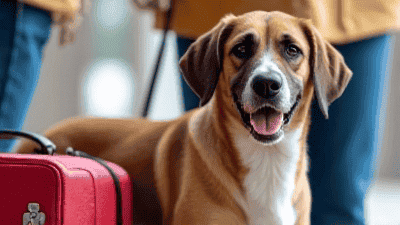
Traveling with your pet can be a rewarding experience, but it also requires careful planning and preparation to ensure their safety and comfort. Whether you’re embarking on a road trip, flying to a new destination, or taking public transportation, there are several factors to consider to keep your pet safe and stress-free.
Before traveling, schedule a checkup with your vet to ensure your pet is healthy and up-to-date on vaccinations. Discuss your travel plans and ask for any necessary medications, such as motion sickness or anxiety relief.
Choose accommodations, attractions, and transportation options that welcome pets. Check for any breed or size restrictions, as well as additional fees.
Ensure your pet has a collar with an ID tag that includes your contact information. If your pet isn’t already microchipped, consider having one implanted and update the registration details with your current address and phone number.
Locate veterinary clinics and emergency animal hospitals along your route and at your destination. Carry a copy of your pet’s medical records and a list of medications they’re taking.

Pack enough of your pet’s regular food for the entire trip, as sudden changes in diet can cause digestive issues. Bring collapsible bowls and a supply of fresh water.
Include any medications your pet requires, as well as a basic first aid kit with items like bandages, antiseptic wipes, and tweezers.
Bring familiar items, such as a favorite blanket, toy, or bed, to help your pet feel more at ease in unfamiliar environments.
Invest in a sturdy carrier, crate, or harness designed for travel. Ensure it provides adequate ventilation and security for your pet.
Pack waste bags, cleaning wipes, and a portable litter box for cats to manage messes during the journey.
Restrain your pet in a carrier or with a seatbelt harness to prevent them from moving around the car or being injured in an accident.
While your pet may enjoy sticking their head out the window, this can expose them to debris, insects, or the risk of falling out.
Feed your pet a light meal a few hours before the trip to reduce the risk of motion sickness. Offer water periodically during stops.
Stop every 2-3 hours to allow your pet to stretch, relieve themselves, and hydrate.
Even with the windows cracked, temperatures inside a car can rise rapidly, putting your pet at risk of heatstroke.

Research airlines that accommodate pets and their policies regarding carrier size, fees, and in-cabin vs. cargo travel.
Opt for a nonstop flight to minimize stress and reduce the risk of mishaps during layovers.
Select a carrier that meets airline requirements and provides enough space for your pet to stand, turn around, and lie down comfortably.
Introduce your pet to the carrier in the weeks leading up to the trip to help them feel more comfortable.
Give yourself plenty of time to check in and go through security with your pet.
Review the rules for pets on buses, trains, or subways. Some services require pets to be in carriers, while others may allow leashed pets.
Keep your pet contained and under control to ensure their safety and the comfort of other passengers.
Travel during less busy times to reduce stress and overcrowding for your pet.
Choose a seat where your pet won’t obstruct walkways or disturb other passengers.

Confirm that your accommodations allow pets and inquire about any additional fees or restrictions.
Check for potential hazards, such as exposed wires or toxic plants, before letting your pet explore.
Stick to your pet’s regular feeding, exercise, and bathroom schedule to help them feel more at ease.
Keep your pet leashed or in a carrier when entering or exiting the room to avoid accidental escapes.
Each country has specific regulations for importing pets, including vaccination, quarantine, and documentation requirements.
Ensure your pet has a health certificate, proof of vaccinations, and any other required paperwork.
Some countries may require pets to undergo quarantine upon arrival. Research the process and prepare accordingly.
If international travel is complex, consider hiring a pet relocation service to handle the logistics.
Acclimate your pet to travel by taking short trips or practicing in the carrier before the journey.
Use anxiety-relief products, such as pheromone sprays, calming coats, or natural supplements, to help your pet relax.
Reward your pet with treats, praise, or playtime to create a positive association with travel.
Your pet can sense your emotions, so remain calm and reassuring throughout the journey.
Bring a copy of your pet’s medical history, including vaccination records and any medications they’re taking.
Research veterinary clinics and emergency animal hospitals at your destination.
Carry a recent photo of your pet and know what steps to take if they go missing.
Consider attaching a GPS tracker to your pet’s collar to monitor their location during travel.
Traveling with your pet can be a wonderful experience, but it requires careful planning and attention to their safety and comfort. By following these essential tips, you can minimize stress and create a positive travel experience for both you and your furry friend. Remember to consult your veterinarian before the trip, pack all necessary supplies, and choose pet-friendly accommodations and transportation options. With proper preparation and care, you and your pet can enjoy exploring new destinations together.